Statement of the Research Problem
During the course of a marriage relationship, Partners may realize that their long-term “heterosexual” partners are something else. On several occasions, we have read news about couples who are forced to break the marriage relationship after one spouse realizes the sad fact that his or her partner is bisexual. Marriage is a solemn and sacred relationship between two partners of the opposite sex, whereby mutual trust, love, and understanding are its key pillars. It is, therefore, a painful experience when one partner realizes that his or her spouse has developed a sexual behavior of being attracted to people of both sexes. Bisexual individuals’ are emotionally, sexually, and affectionally attracted to members of the opposite sex as well as to their own sex.
This research aims at investigating the reactions of married women when they realize that their most trusted husbands do not have a heterosexual orientation but indeed are bisexually oriented. The paper will rely heavily on sociological perspectives of heterosexuality and bisexuality and the arguments that are likely to guide the women’s reaction to their husband’s bisexual nature.
Literature Review
According to Galopo (2008), arguments for or against same-sex marriages have generated more heat when the debate turns to bisexual men and women. Many contemporary marriages are between heterosexual members of the opposite sex. According to Baron (2003), heterosexuality refers to a state of sexual attraction to members of the opposite sex. Heterosexuality is an enduring disposition or pattern that makes individuals experience affectional, sexual, or romantic attractions primarily to individuals of the opposite sex. Women are bound to react unkindly when they find that their partners do not fit the above description. Their husbands may have developed a bisexual orientation, whereby they are attracted to members of the opposite sex as well as to members of their own sex. More specifically, the husbands may be psychosexual hermaphrodites. According to Storr (1999), psychosexual hermaphroditism is an awkward name given to the form of individual inversion whereby sexual attraction or orientation is directed at both sexes. Psychosexual hermaphrodites find sexual satisfaction and pleasure both with men and women.
According to Baron (2003), most societies assume that everybody is heterosexually oriented. As Such, it is normal for straight people to get angry and feel shocked when they realize that their partners may be bisexuals, or worse still, asexual. Storr (1991) defines asexual people as individuals who fail to experience sexual attraction to either sex. Such a condition can develop later on in life, even when an individual was heterosexual. Sociological surveys have revealed that social prejudices against bisexual people, especially when they don’t know of other people who may be bisexual. According to Baron (2003), someone who lacks first-hand information will definitely lean on stereotypes to explain an occurrence. The woman’s reaction will therefore be informed by the society in which she lives. If there are no other bisexuals in the society and her husband is the first one, she may react in an explosive manner, according to Horncastle (2008). However, this may not be the case when there are known bisexuals who live amidst the women in society.
According to Horncastle (2008), the most important thing for people to do when they are faced with such a situation is to realize that the bisexual partner is exactly the same person that they knew before his status was known to the community. The perceptions towards the bisexual may have changed, but the nature of the person hasn’t. Therefore, to accommodate such people in our society, individuals need to sift through their perceptions and differentiate between those that are based on stereotypes and those based on their own experiences.
According to Baron (2003), available studies show that bisexuality and homosexuality are not the results of bad parenting or bad influence. The traits do not run in families. Rather, bisexuality and homosexuality seem to take place with equal frequency in all families regardless of ethnicity, educational level, or financial status. Therefore, in dealing with bisexuals and homosexuals, individuals need to view them within the broader social context instead of personalizing issues.
Bisexuals and homosexuals often find it difficult to “come out” of their closet lives or be open on their sexual orientations basically because of the stigma that society puts on them (Cole, Manoh, & Muscher, 2007). According to Baron (2003), “coming out” is a practice whereby individuals come into the open and tell other people about their sexual orientation – either bisexual or homosexual. This process is a symbolic emergence from self-censorship that allows individuals to live more honest-filled lives rather than living in hypocrisy and lies.
But due to the harsh response that society offers them, the majority of the bisexuals and homosexuals prefer to blend within the wider community and even hide under cover of heterosexual relationships while secretly maintaining their bisexual and homosexual relationships (Cole, Manoh, & Muscher, 2007). The aim of engaging in such a behavior is to develop “comfort zones” where they complacently subsist in a segregated and different lifestyle. Their daily fear is how society will react to them if it comes to know about their sexual orientation. In relation to the dominant culture, bisexuals and homosexuals lack to feel a sense of belonging. To cope with societal demands, they reconstruct some affirming identities for themselves.
According to Shawn (2008), many wives discover their partner’s bisexual orientation through website browser histories or through emails. Such a discovery elicits emotions that can range from betrayal, shame and feelings of guilt. The wife should first spend time with the knowledge of bisexual activity before deciding on her next course of action. The wife should then try to obtain some information about other bisexuals and then talk to her partner. Both can choose to get some counseling from professional psychiatrists, psychologists, or social workers. According to Shawn (2008), the best thing for such partners to do is to join a support group since no partner can effectively be able to change the sexual orientations of the other. In such support groups, the partners will learn from the experiences of others, pose questions, and get some advice.
Hypothesis
This study assumed that negative reactions of betrayal, shame, and guilt, that are experienced by a partner in a straight-bisexual relationship come out as a result of a lack of information and knowledge about the other partner’s bisexual activities. The study also assumed that wives were not in a position to change the bisexual orientation of their partners since it seems to take place with equal frequency in all families regardless of educational level, ethnicity, or financial status. Finally, the study assumed that society rather than individuals are to blame for stereotyping bisexuals, thus effectively making them not reveal they’re true identities. The basis for these assumptions was informed by the results of previous studies.
Methods
This research focused on the reactions of women when they know that they are engaged in a straight-bisexual type of marriage relationship. To this end, questionnaire administration was deemed to be the most appropriate method of data collection. According to Creswell (2008), a questionnaire is one of the best research instruments as it minimizes the measurement error. A questionnaire containing some open-ended questions was developed for the purposes of data collection. According to Cohen, Manion, & Morrison (2002), a questionnaire enables people to express their views and opinions freely without having any limitations. Questionnaires are also able to catch the richness, authenticity, honesty, candor, and depth of response.
Questionnaires were to be administered personally. According to Creswell (2008), personal administration has the obvious advantage of making the respondent understand the questions and concepts involved. Personal administration also gives a respondent the opportunity to ask for clarifications. Personal administration also yields the lowest refusal rate among respondents. It also allows for detailed, longer, and more complicated interviews to be undertaken.
The questionnaire was administered to married straight women between the ages of 18 to 70 years. The questionnaire was specifically administered to married straight women because the study wanted to capture the reactions of these women towards bisexual partners. The questionnaire was administered on a sample size of 150 respondents, who were randomly selected from homes north of Jacksonville city in Florida, U.S. The City has a population of 805,605 people and a population density of 970.9 meters squared. The study was commissioned in 2008. (N.B. Questionnaire attached in appendix).
Data collection
Although the city of Jacksonville has approximately 805 605 people, the study was only limited to the Northern suburb. This was due to the constraints of time and travel costs. A more comprehensive study would have shed more light on women’s reactions to bisexual husbands. Overall, the process of data collection went on smoothly without major occurrences save for a few logistical problems as the respondents were out of their homes most of the time. This was sufficiently dealt with by personal administration of the questionnaire when respondents became available, mostly in the evening.
Data analysis
Quantitative data for the study were analyzed using the Statistical Package for Social Sciences (SPSS) and Excel Spreadsheets to generate frequencies and percentages needed to answer the research assumptions. Basically, the study aimed at discovering the reactions of women towards their bisexual partners in case they came across the information that their husbands were not heterosexual. Other pertinent issues that the study wanted to inquire about are whether the women had the ability to change the sexual orientations of their partners and whether society had a role to play in making bisexuals fear to reveal they’re true identities. The results are presented below.
All the respondents were between the ages of 18 to 70 years. They had been married for periods between 2 years and 50 years. Their husbands were between the ages of 21 to 75 years. Fifty percent of the respondents interviewed lived together with their husbands in their matrimonial home, while 35 percent lived in separate homes. More than two-thirds of the respondents believed that husbands who stayed alone were more likely to engage in bisexual behavior than those who lived together with their wives. This shows a clear lack of knowledge, as according to Baron (2003), bisexual traits do not run in families but rather seem to take place with equal frequency in all families regardless of financial status, ethnicity, or educational level.
Nearly all respondents (88%) believed that their husbands were heterosexual. Of the remainder, some 50 percent argued that their husbands exhibited some strange sexual behaviors, while 42 percent said that they had seen some suspicious emails from people who were more likely to be bisexual. The high number of respondents who believe that their husbands are straight points to the fact that no woman would ever want her partner to be bisexual. This is reinforced by the fact that a combined 90 percent of the respondents would carry feelings of guilt, despair, shame, and inward hatred towards themselves if they came to know that their husbands were bisexual. Another 70 percent said that they would not be willing to listen to the explanations offered by their husbands if they realized by themselves that their partners have been hiding their sexual orientations from them. This shows how society is unforgiving to people with other sexual orientations apart from heterosexuals. It reinforces Baron’s (2003) revelation that societies assume that everybody is heterosexually oriented. It also reinforces the study’s assumption that society is to blame for making bisexuals not reveal they’re true identity.
According to Baron (2003), most societies assume that everybody is heterosexually oriented. According to Cole, Manosh, and Muscher (2007), bisexuals prefer to blend within the wider community and even hide under cover of heterosexual relationships to escape from the harsh censure that society handles them. Below is an illustration of the percentages.
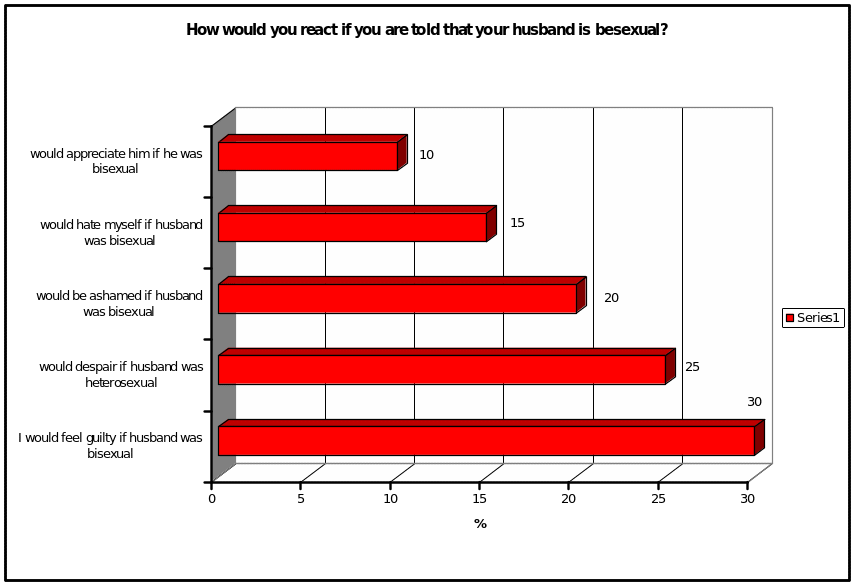
Almost three-quarters of the respondents believed that they hold power to change their husbands’ sexual orientations. This again suggests a lack of information and knowledge basically because sexual orientations cannot be changed by individuals (Storr, 1999). Lack of information on bisexual issues was prevalent as only 30 percent of the respondents had adequate information about the issue. The internet and newspapers were their most valued sources. Two-thirds of the respondents said they would leave their husbands if they realized their bisexual orientation. This again reinforces the study’s assumption that women are more likely to react negatively owing to their lack of knowledge on the issue. Only 20 percent knew of some bisexual social network, with Apple Brotherhood receiving the highest score. This suggests a lack of interest in bisexual issues as Jacksonville city has around 12 bisexual social network groups.
A whole 80 percent of the respondents believed that society carried bisexuals negatively and tried to shun them. Half of the respondents believed that bisexuals hide their true identity for fear of rebuke from society, while 30 percent said bisexuals were just naughty to hide their own identity. This reinforces the study’s assertion that society treats bisexuals badly. Below is an illustration of some key findings.
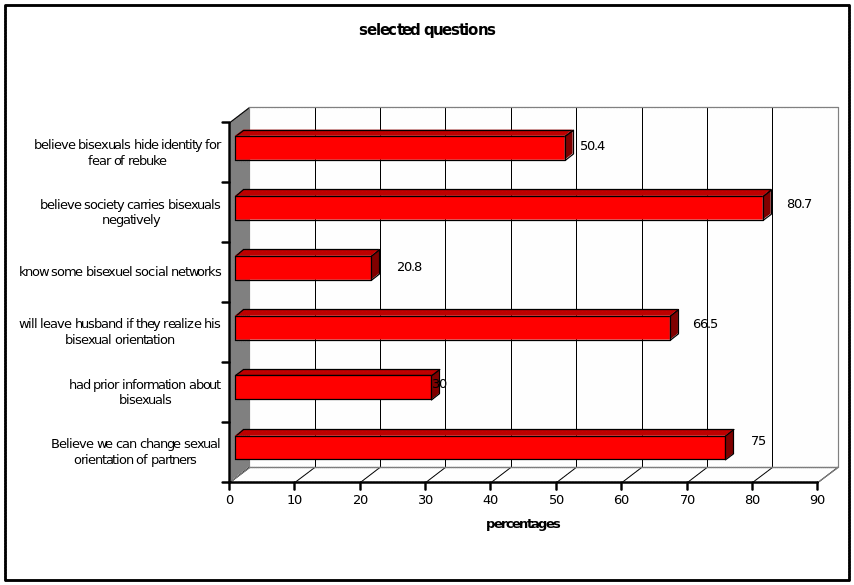
The above analysis clearly reinforces all our study assumptions. The study clearly shows that women are likely to react negatively if they realize that their husbands are bisexuals.
Datasheet
Age of respondent: From 18 to 70 years:
- Duration respondents have been married: 2 to 50 years.
- Age of husband: 21 to 75 years.
- If the respondent lives in the same house with husband: 50% yes; 35 % no.
- Can living apart influence bisexuality: 67% yes; 33% no.
- Believe in husband’s sexual orientation: 88% heterosexual.
- Reaction if told that your husband is bisexual: A combined 90 % will experience feelings of guilt, despair, shame, and inward hatred.
- Willing to listen to husband’s explanation: 70% no.
- Do you have the power to change your partner’s sexual orientation: 75% yes.
- Are you knowledgeable enough to talk about bisexuality: 70 % no.
- The current source of Knowledge about bisexuals: Mostly Internet.
- Would you leave your bisexual husband if you realize: 66.5% yes.
- Why would you leave him: 75% for not revealing his condition.
- Do you know of any bisexual networks: 20.8% yes.
- Can you list the social networks you know: The majority know Apple Brotherhood.
- Why do you think bisexuals hide their identity: 50.4% rebuke; 30% naughty.
Conclusions and Recommendations
The study revealed how society carried the bisexuals negatively, and thereby impacting married women’s reaction in case they came to know about the bisexual orientation of their husbands. Married women are expected to follow the values and norms set by the society they live in. If society despises and views bisexuals as undignified individuals, women will be left with no other option other than to hate the practice, no matter how they may love their husbands. This study has clearly shown that society only condones heterosexual relationships and despises the rest, including bisexuals. This study has also reinforced the idea that the majority of women are inadequately endowed with information and knowledge about bisexual activities and their causes. As such, they tend to negatively react whenever they know that their husbands are indeed bisexuals, with the majority of them reporting feelings of guilt, shame, and inward hatred. If adequate information about the bisexual activity is made available, the trends of negative feelings are more likely to change. Finally, the study has underscored the important part that society continues to play in making sure that bisexuals don’t come to the open. Society harshly criticizes bisexuals, and as such, they prefer to remain in the dark.
More research needs to be conducted to find ways in which society can be more receptive to people with different sexual orientations. We do not need to banish them in total. Ways must be found through which we can effectively bring bisexuals members on board.
Questionnaire
Note: This questionnaire is administered to women in-between the ages of 18 – 70 years for the purpose of gauging their reactions to bisexual orientations. The information filled therein will be strictly private and confidential and will be used for the purposes of this research only. Thank You.
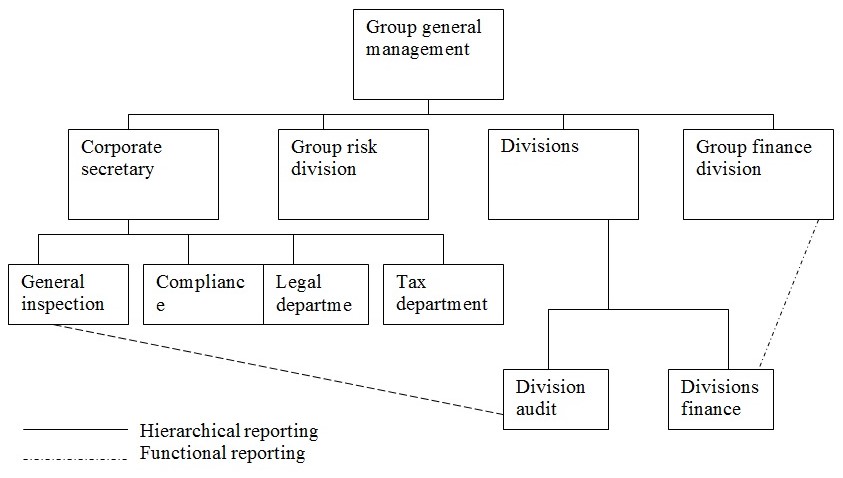
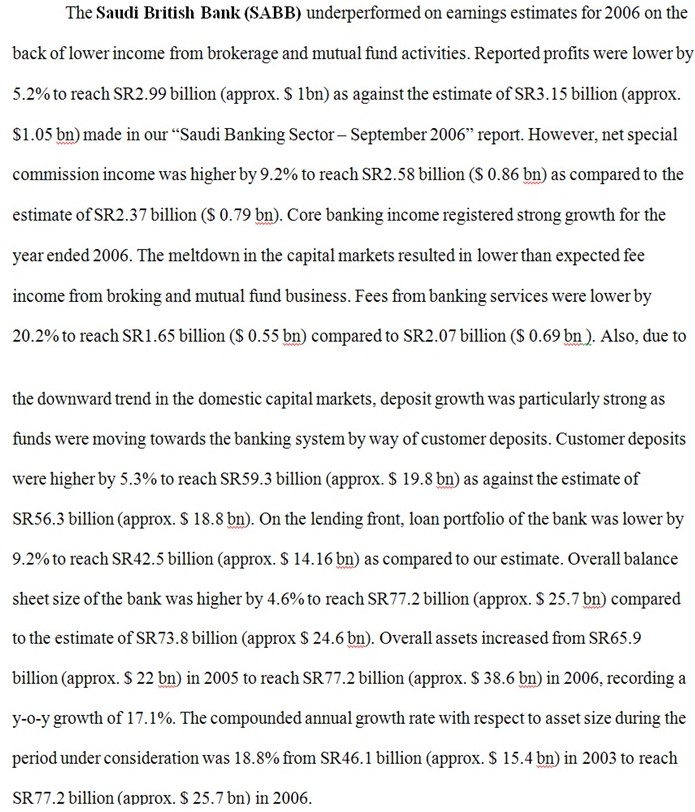
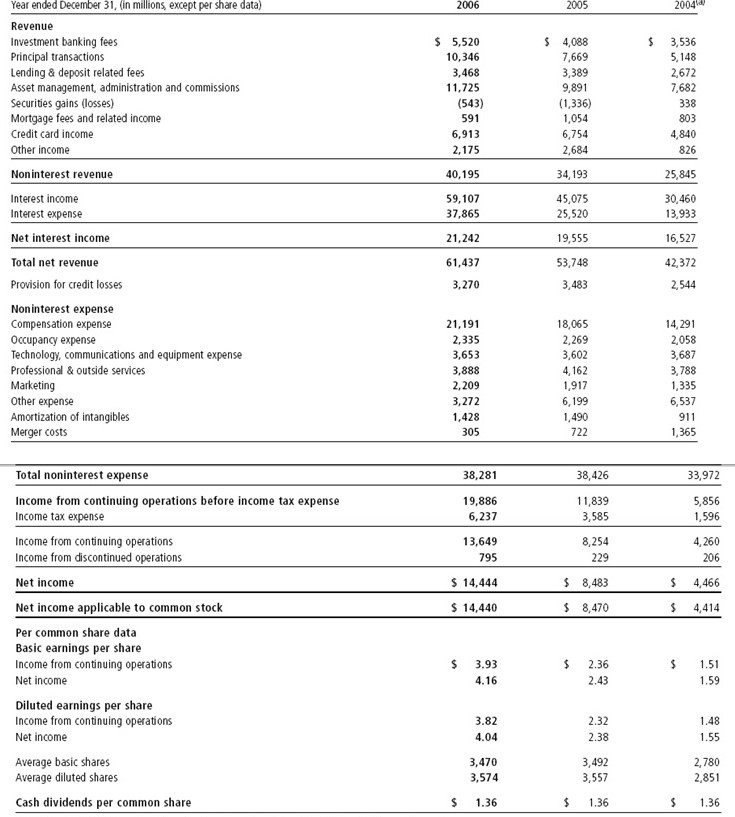
References
Baron, T. (2003). How to cope with a bisexual husband. EHow. 2008. Web.
Cole, C.M., Manuh, T., & Miescher, S. (2007). Africa after gender? Indiana University Press.
Creswell, J.W. (2008). Educational Research: Planning, Conducting and Evaluating Quantitative and Qualitative Research. New Jersey, Prenhall.
Galupo, M.P. (2008). “Bisexuality and same-sex marriages.” Routledge Sociology. Web.
Horncastle, J. (2008). “Queer bisexuality: Perceptions of bisexual existence, distinctions, and challenges.” Journal of Bisexuality, vol. 8, no. 2, pp 1-2. Web.
Shawn, R. (2003). “Coming out” BBC. 2008. Web.
Storr, M. (1999). Bisexuality. Routledge. 2008. Web.